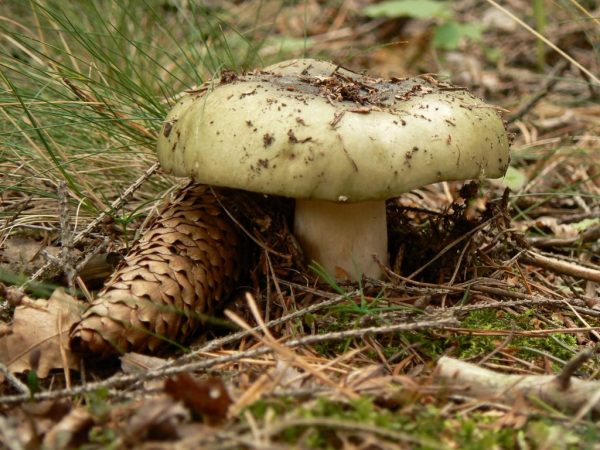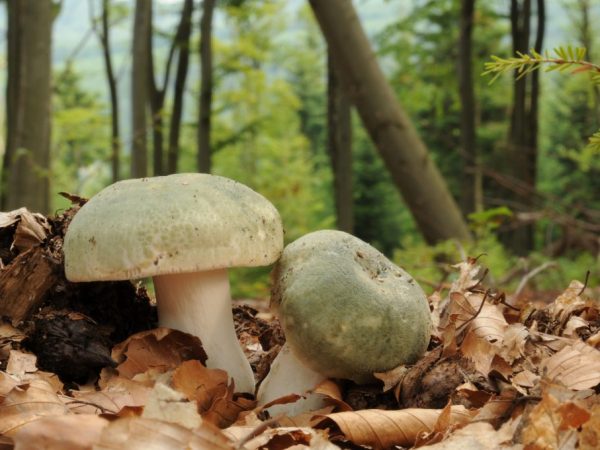Description of the green russula and its double
Russula is a genus of russula, which includes more than 60 varieties, differing in color and properties. These mushrooms are not demanding on soil composition and climatic conditions. The russula green and its counterpart are found in mixed forests. They usually grow singly or in small families of 3-5 pieces.

Description of the green russula and its double
Description of the mushroom
These fungi form mycorrhiza with the root system of deciduous and coniferous trees, i.e. they are active mycorrhiza formers. Distributed throughout the world. Knowing the exact description of the appearance of the green russula, it will be possible to avoid poisoning its poisonous double.
The hymenophore has a lamellar structure and is white. The plates are often located at the stem, but diverge closer to the edge of the cap. Near the pedicle, the plates can occasionally branch. With aging, the hymenophore acquires a fawn hue. The diameter of the cap is 5-10 cm, depending on age and habitat conditions. In young specimens, the shape of the cap is usually semicircular, in old specimens it is spread out with a wavy edge and clearly visible scars.
In a young mushroom, the cap is covered with mucus. It dries and becomes shiny. The color is greenish or off-white. In an old mushroom, the color of the cap becomes green-olive.
The height of the leg is 4-7 cm, the diameter is 2-3 cm. The leg itself is cylindrical, not hollow inside, smooth, white in color. In old mushrooms and in specimens growing during drought, brown spots appear on the stem. White pulp has a pleasant mild sweetish taste. But for the plates, a pungent taste is characteristic. When pressed, the inside of the mushroom turns brown, exudes a barely perceptible pleasant aroma.
In nature, there is a green scaly variety. Differs from the usual structure of the cap surface. Flakes of a light green color are clearly visible on it. The surface of the cap feels airy.
Poisonous doubles and false russules
The russula has poisonous counterparts: pale toadstool, fly agaric.
The greenish russula bears a resemblance to the young pale toadstool. The leg of a young mushroom is poorly visible. This is the most common reason why a poisonous twin ends up in a mushroom picker basket.
Irina Selyutina (Biologist):
About the pale toadstool, you need to remember that:
- In clinical practice, poisoning with it is classified into mild, moderate and severe.
- Not only the mushroom itself is poisonous, but also its spores.
- Nearby located (within a radius of about 1.5-2 m) mushrooms and berries, as well as flowers, cannot be torn off - its mycelium can transfer some of the toxins to these forest dwellers and make them hazardous to health.
- Toadstool toxins are resistant to high temperatures and gastrointestinal enzymes.
The edible mushroom has distinctive features common to the genus russula:
- no Volvo ring;
- barely perceptible pleasant smell.
An adult edible specimen is easier to identify: its leg is clearly visible, the cap becomes depressed in the central part, which is not manifested in the pale toadstool.If you dig the soil under the toadstool, you can see that it grows from a kind of formation that resembles a bag or egg (volva). The top of the double's hat is convex, and 2 rings are visible on the leg: below and above. A distinctive feature of toadstool is a pungent, unpleasant smell of pulp.
The scaled variety is confused with the fly agaric. The main difference between them: in russula, the scales firmly adhere to the cap, in the fly agaric - they are easily peeled off. In nature, russula are found, which are not desirable to eat because of their inedibility:
- The russula is caustic, or pungent: the cap is convex, light red. The pulp and stem are white, exude a fruity aroma, and have a pungent, unpleasant taste.
- Pungent russula, or yellowing: cherry hat with a purple tint. The pulp is dense, yellow, smells like fruit. Eating is fraught with gastrointestinal upset.
- Blood-red russula: the cap has a color and gave the name to the species - bright red. The cut flesh is yellow. The species is conditionally edible. Indigestion when eaten raw.
Beneficial features

The mushroom is suitable for dietary nutrition
The fruit body of the green russula contains a lot of vitamins and minerals necessary to provide the human body with energy. 20% of the mushroom body is protein. Contains calcium, phosphorus, magnesium and iron.
The calorie content of the mushroom is 12 kcal per 100 g of pulp. Refers to dietary products. Regular use helps prevent blood clots.
Contraindications
Green russula are contraindicated:
- children under 8 years old;
- pregnant and lactating women;
- People suffering from kidney disease, gastritis.
When using russula, the daily norm of 150 g should not be exceeded. Products must undergo thorough heat treatment. Undercooked or raw, they cause gastrointestinal upset, usually accompanied by vomiting and diarrhea.
Attention! A pickled product, consumed in large quantities, causes an exacerbation of liver diseases. Even an edible mushroom collected near the city, near roads and factories, causes severe poisoning, so you need to carefully choose the mushroom place.
Application
Due to its healing properties and a number of vitamins in its composition, the product has found wide application in cooking and medicine. It is included in the diet for "drying" the body and intense training. The increased protein content allows you to quickly restore muscle tissue damaged during increased physical exertion, and improve metabolism.
The use of this product in the amount of 150 g / day has a positive effect on the state of the nervous system and immunity. Protein components actively restore the tissues of the walls of the vascular network, preventing their blockage (thrombosis), and contribute to the elimination of toxins. High iron content increases the level of hemoglobin in the blood.
The inedible analogue - blood-red russula - is used as a raw material for tinctures. The extract from it contains useful trace elements and substances that allow you to create homeopathic remedies.
In cooking
Russula are used fried, pickled, salted. Before cooking, the product is thoroughly washed from dirt. The hat is peeled off by prying the edge with a knife. Slightly cut the core.
A cleaned, prepared fruit body requires instant processing while the flesh is not yet yellow. It is important not to allow it to darken. Boil the mushrooms for 20 minutes, then drain the water and pour in a new one, boil for another 20 minutes with the addition of spices, bay leaves and onions. After this preparation, they can be fried, stewed or rolled up in jars.
Raw mushrooms contain the enzyme russulin. It is used in the manufacture of rennet cheeses and cottage cheese.
In medicine
Russula has found wide application in medicine.Traditional healers have long used it in the treatment of abscesses, abscesses and pyoderma (purulent skin lesions that develops as a result of the penetration of bacteria into the body - pyogenic cocci). In traditional medicine, mycelium extract is used in the production of drugs for cancer patients. The mushroom is actively used in dietary nutrition in the treatment of thrombosis and cardiovascular pathologies.
Mushroom juice is used in the fight against corns. Tincture of russula vodka is effective in treating colds. It is also used externally for rubbing. The inedible mushroom russula pungent is suitable for the production of hemostatic drugs.
Conclusion
Green russula are useful edible organisms that are widely used not only in cooking, but also in medicine. They are capable of replacing meat products, which makes them attractive to vegetarians. The high content of the vitamin and mineral complex has a beneficial effect on the condition of the skin, nail plates, teeth. The most dangerous inedible double is the pale toadstool.



